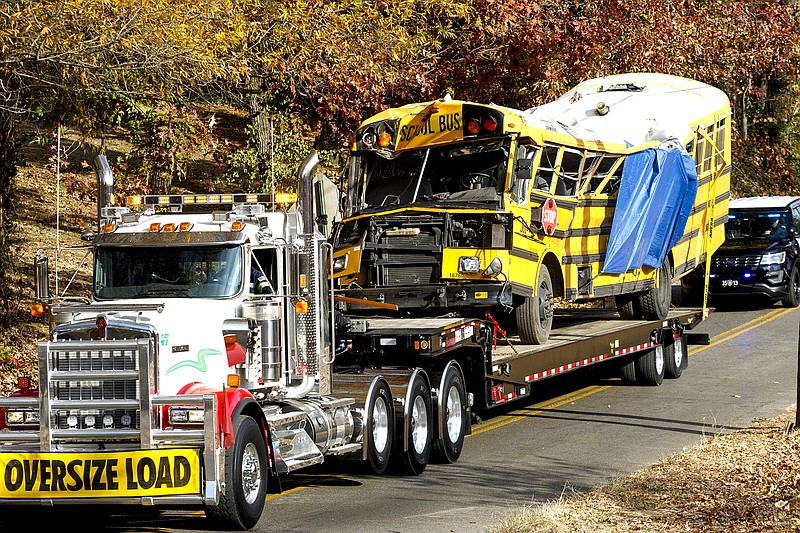
NASHVILLE - A bill requiring all Tennessee school buses be equipped with safety restraint systems by mid-2023 cleared its first House hurdle Wednesday after two Chattanooga physicians gave dramatic testimony about the "terrible night" in November when a Hamilton County school bus crashed, killing six children and injuring others.
"I truly believe that the pain of those families and suffering of their children could have been prevented or lessened," Dr. Alan Kohrt, a pediatrician and chief medical officer at Children's Hospital at Erlanger, told Transportation Subcommittee members.
He said that included not just the seat belt bill sponsored by Rep. JoAnne Favors, D-Chattanooga, but another Favors bill. It requires school bus drivers be at least 25 years old and have had a five-year clean driving history before getting licensed by the state to transport students.
The Hamilton County grand jury this month indicted 24-year-old bus driver Johnthony Walker on six counts of vehicular homicide, four counts of reckless aggravated assault and one count each of reckless endangerment and reckless driving.
Sitting in the Legislative Plaza committee room's audience were several parents and their children, who survived the crash. Police allege Walker was speeding when the bus, carrying 37 children and traveling on a curvy section of Talley Road in Brainerd, struck a utility pole, overturned and slammed into a tree.
Favors' bill, which would require all new buses to come equipped with seat belts beginning next year, has a huge cost, according to a legislative fiscal analysis. It would cost the state $58.7 million, and local governments $423.4 million, according to the fiscal note.
The costs have some lawmakers balking. And so do arguments by school bus drivers and, in the past, national safety officials, that the compartmentalized construction of bus seats provides adequate safeguards have some lawmakers balking.
Other concerns include whether children will obey and belt themselves in and what happens in a crash if they're trapped by the seat belts.
Subcommittee Chair Terri Lynn Weaver, R-Lancaster, raised the latter issue of what would happen if there was a fire.

"That's a big concern," Weaver said. "God help that bus driver who could not get a kid out."
Dr. David Bhattacharya, a pediatric surgeon who worked at Erlanger the day of the fatal crash, said the buses would be equipped with bolt cutters.
He described in sometimes graphic detail the blunt force trauma suffered not just by the Woodmore Elementary School students killed in the Nov. 21 crash but other students with head injuries and broken limbs that will follow some throughout their lives.
While the transport industry argues that compartmentalization provides adequate safety, Bhattacharya said a number of children were "free floating within this open can of the bus" as it turned over on Nov. 21.
One girl's chest struck the seat in front of her with such force that it caused major internal bleeding, Bhattacharya said.
Kohrt emphasized that the National Transportation Safety Board, which is investigating the Chattanooga crash, has in the past few years recommended school buses be equipped with three-point safety harnesses.
So has the chief of the National Transportation Safety Administration, as well as the American Academy of Pediatricians and the National Association of State Directors of Public Transportation Services, Kohrt said.
Rep. David Alexander, R-Winchester, a panel member, said his daughter works in the nuclear medicine section of Children's Hospital and was there as injured children came in.
"Thank you, sir, for doing what you did," he told Kohrt.
Most of the panel's time had been consumed previously by a lawmaker who had two bills targeting traffic cameras. As a result, Favors and the doctors had about 15 minutes to make their arguments for the bill.
"We've got to discuss this more," Weaver said of Favors' bill. "This is an important issue. We're talking about safety."
Favors agreed, saying, "We're all concerned about the safety of our children. And I hope we will be able to work on this bill to make it palatable."
Weaver said, "That's why we want to have more time to talk about this" and noted it needed to move into full committee for that. The bill then moved out.
Favors said she is looking at lengthening the phase-in period of the requirement in order to try to allay concerns about costs coming in a relatively short time frame.
Among those attending the hearing was Alexandria Frazier and her daughter, Canasia, 11, who was injured in the crash.
"I broke my wrist and I had two concussions," Canasia said.
Her mother noted doctors said that wouldn't have happened had she been wearing a seat belt.
Bhattacharya said that's to be expected.
"The bus stopped. She did not. They put their arms out. They keep moving forward."
Contact staff writer Andy Sher at asher@timesfreepress.com or 615-255-0550. Follow him on Twitter @AndySher1.
